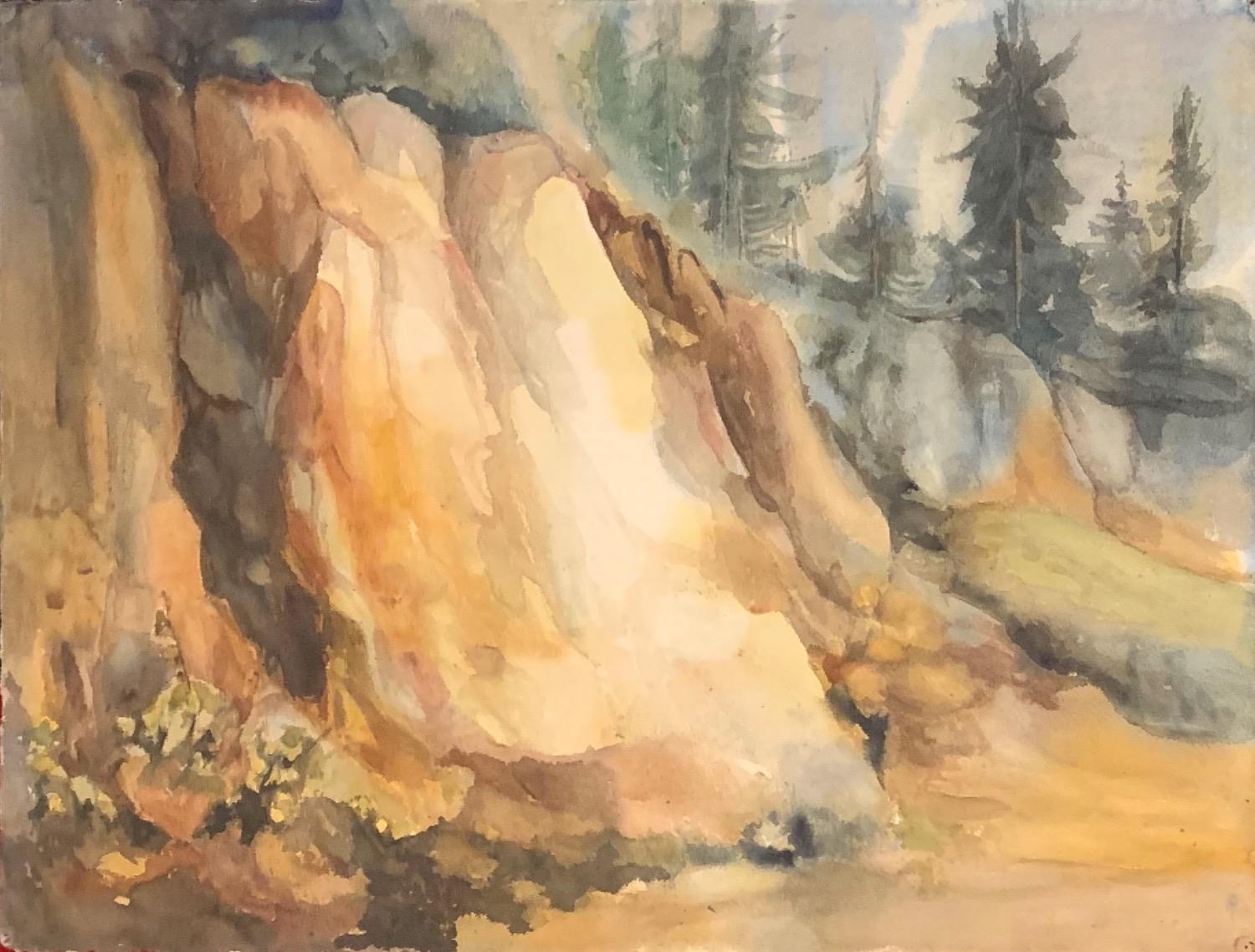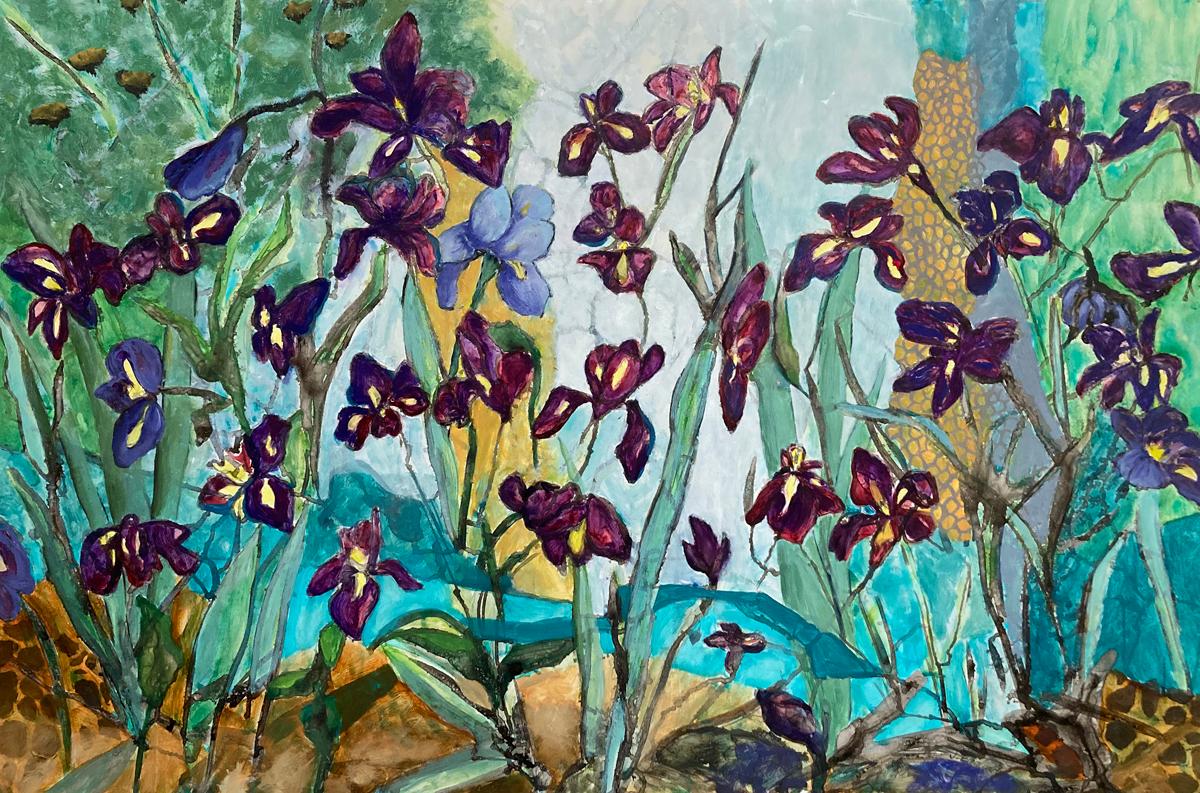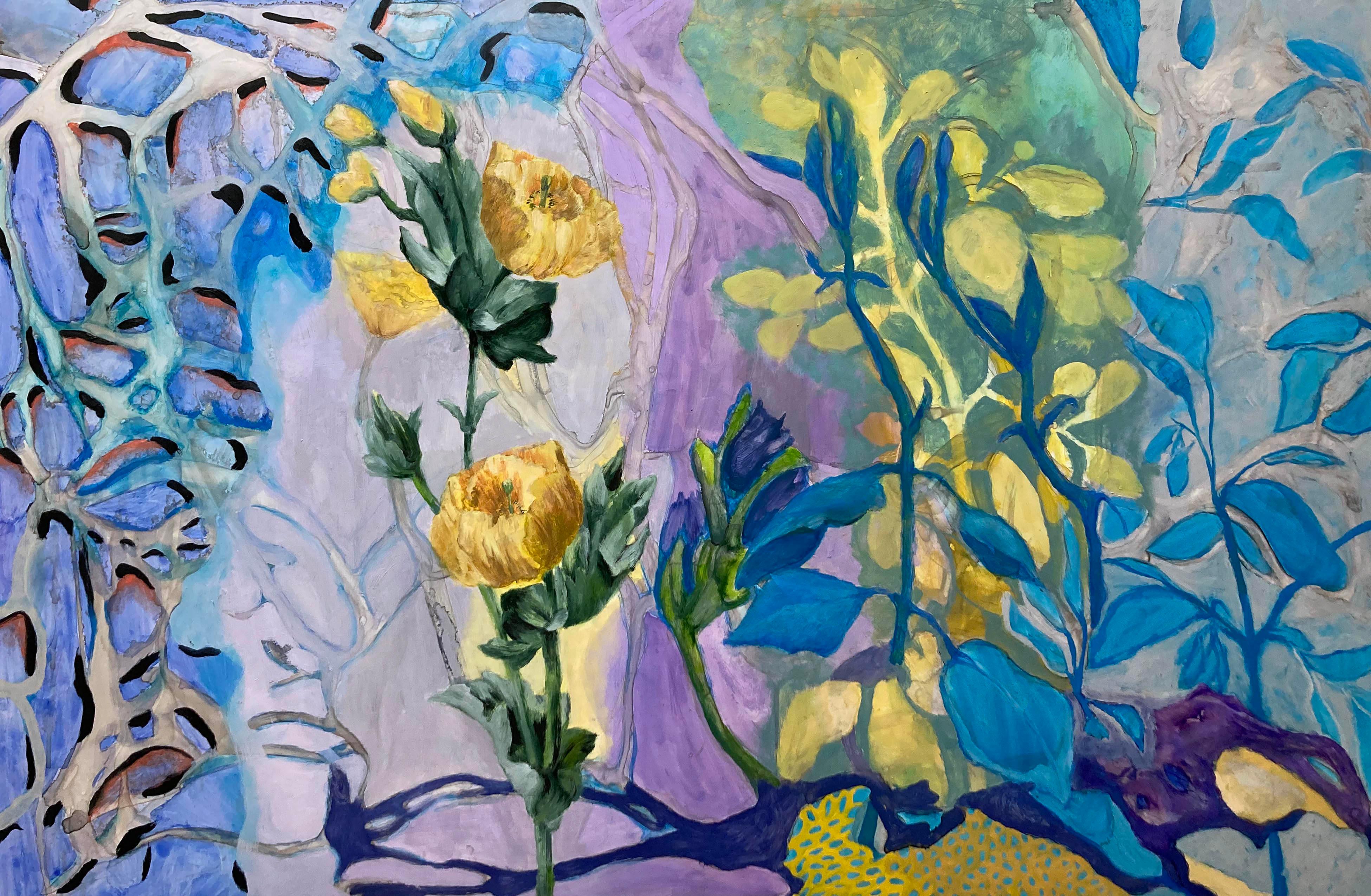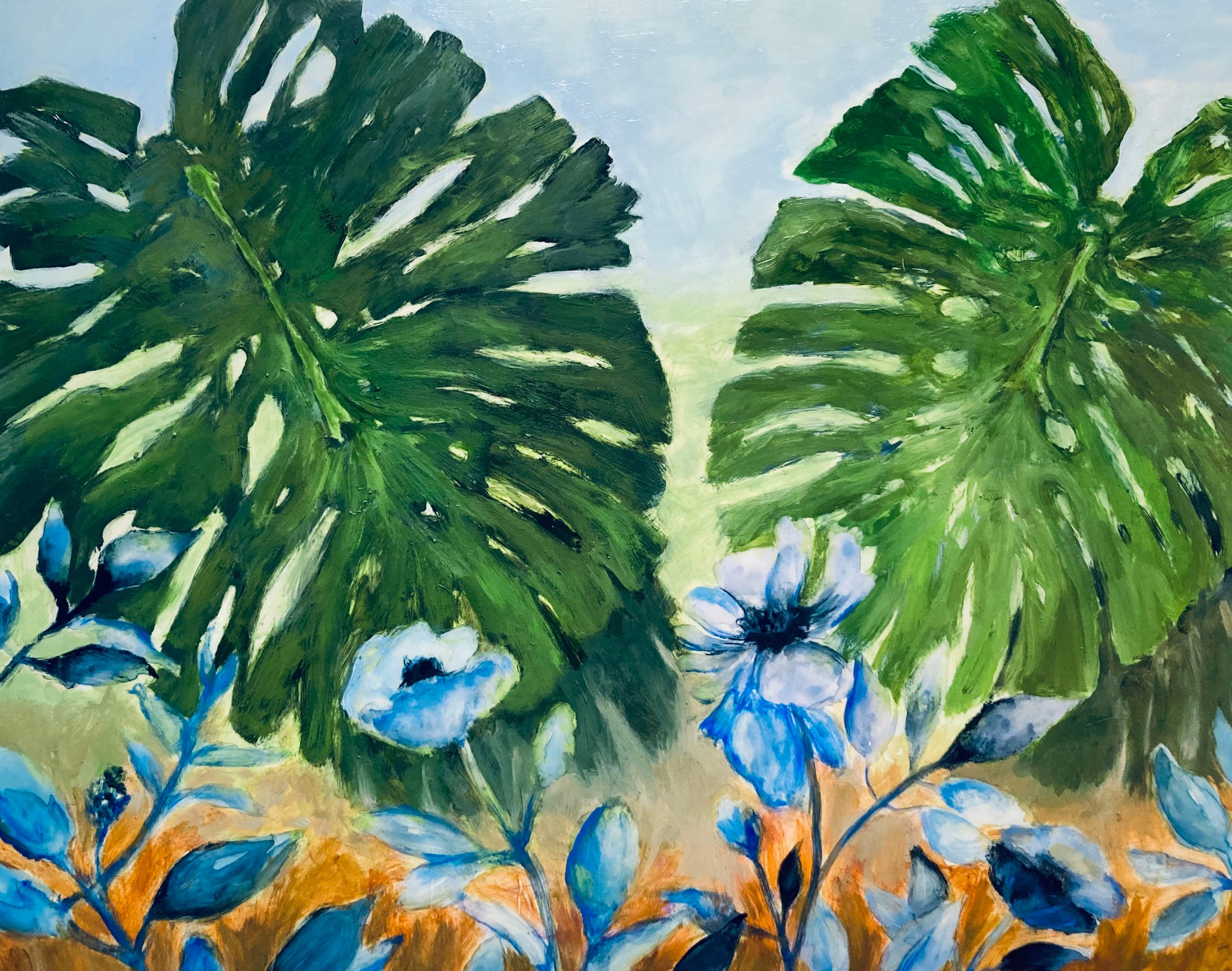Items Similar to "Afternoon Sun, " Ann Wyeth McCoy, Interior and Landscape
Want more images or videos?
Request additional images or videos from the seller
1 of 8
Ann Wyeth McCoy"Afternoon Sun, " Ann Wyeth McCoy, Interior and Landscape
About the Item
Ann Wyeth McCoy (1915 - 2005)
Afternoon Sun
Watercolor on paper
Sheet 24 x 18 inches
Signed lower left
Provenance:
Somerville Manning Gallery
Private Collection, Delaware
Pook & Pook, May 21, 2021
Ann Wyeth McCoy was born on March 15, 1915, in Chadds Ford, PA, to Newell Convers (N. C.) and Carolyn Brenneman Bockius Wyeth. Her father, an accomplished illustrator and artist, had moved to the area in 1902 to study with illustrator Howard Pyle. In 1911, with proceeds from his illustrations from "Treasure Island", N. C. Wyeth built his studio and home in Chadds Ford where all of his five children were born and raised.
Mrs. McCoy's older brother Nathaniel was an engineer for Dupont Company; her sisters, Henriette (Mrs. Peter Hurd) and Carolyn, were painters; and her younger brother, Andrew, is also a painter.
Although her father gave her painting lessons as a child, her main interest was in music. She studied piano with William Hatton Greene and composition with Harl McDonald.
In 1934, when Mrs. McCoy was only 19 years old, one of her compositions was played by the Philadelphia Orchestra with Leopold Stokowski conducting. Other compositions have been performed by the Kennett Symphony, the Germantown Symphony, the Main Line Symphony, by organists at Longwood Gardens, and in local churches. Many of her works have been written in honor of or in memory of relatives and friends.
In 1935, she married John W. McCoy II, a former student of N. C. Wyeth, who taught watercolor painting at the Pennsylvania Academy of Fine arts in Philadelphia. Together, they had three children, Ann Brelsford McCoy (also of Chadds Ford); John Denys McCoy, of Ruidoso, New Mexico; and Maude Robin McCoy Bent of Canaan, New Hampshire.
For many years, Mrs. McCoy has collected antique dolls. Her extensive collection has been exhibited often at the Brandywine River Museum. The large dolls are dressed in original clothing and in costumes designed and made by Mrs. McCoy from antique fabrics.
In recent years, Mrs. McCoy has returned to painting, primarily landscapes in watercolor. One of her early paintings is in the collection of the Hotel du Pont, and her work has been exhibited in numerous local galleries including the Chadds Ford Gallery and the Somerville-Manning Gallery.
- Creator:Ann Wyeth McCoy (1915 - 2005, American)
- Dimensions:Height: 35 in (88.9 cm)Width: 29 in (73.66 cm)
- Medium:
- Movement & Style:
- Period:
- Condition:
- Gallery Location:New York, NY
- Reference Number:1stDibs: LU1841210307802
About the Seller
5.0
Platinum Seller
These expertly vetted sellers are 1stDibs' most experienced sellers and are rated highest by our customers.
Established in 2021
1stDibs seller since 2022
63 sales on 1stDibs
Typical response time: <1 hour
- ShippingRetrieving quote...Ships From: Larchmont, NY
- Return PolicyA return for this item may be initiated within 3 days of delivery.
More From This SellerView All
- "The Red Silo" Winold Reiss, Rural Regionalist Landscape, Sunny Day on FarmBy Winold ReissLocated in New York, NYWinold Reiss The Red Silo Signed lower left Watercolor on paper 20 x 29 inches Winold Reiss (1886-1953) was an artist and designer who emigrated to the United States from Germany in 1913. Probably best known as a portraitist, Reiss was a pioneer of modernism and well known for his brilliant work in graphic and interior design. A compassionate man who greatly respected all people as human beings, he believed that his art could help break down racial prejudices. Like his father Fritz Reiss (1857-1915), who was also an artist and who was his son's first teacher, Winold Reiss was artistically moved by diverse cultures. The elder Reiss focused on folk life in Germany while Winold drew substantial inspiration from a range of cultures, particularly Native American, Mexican, and African-American. As did many young aspiring artists, Winold Reiss studied with the esteemed painter and teacher Franz von Stuck at the Royal Academy of Fine Arts in Munich, which was at that time a center of the decorative and fine-arts movement. It is not known whether Reiss met E. Martin Hennings...Category
Mid-20th Century American Realist Landscape Drawings and Watercolors
MaterialsPaper, Watercolor
- "Tugboat at Dock, " Reginald Marsh, Modern WPA Industrial ShipBy Reginald MarshLocated in New York, NYReginald Marsh Tugboat at Dock, circa 1937 Signed lower right Watercolor and pencil on paper 13 3/4 x 20 inches Housed in a Lowy frame. Provenance: Sotheby'...Category
1930s Modern Landscape Paintings
MaterialsPaper, Watercolor, Pencil
- "Train Station, " Max Kuehne, Industrial City Scene, American ImpressionismBy Max KuehneLocated in New York, NYMax Kuehne (1880 - 1968) Train Station, circa 1910 Watercolor on paper 8 1/4 x 10 1/4 inches Signed lower right Provenance: Private Collection, Illinois Max Kuehne was born in Halle, Germany on November 7, 1880. During his adolescence the family immigrated to America and settled in Flushing, New York. As a young man, Max was active in rowing events, bicycle racing, swimming and sailing. After experimenting with various occupations, Kuehne decided to study art, which led him to William Merritt Chase's famous school in New York; he was trained by Chase himself, then by Kenneth Hayes Miller. Chase was at the peak of his career, and his portraits were especially in demand. Kuehne would have profited from Chase's invaluable lessons in technique, as well as his inspirational personality. Miller, only four years older than Kuehne, was another of the many artists to benefit from Chase's teachings. Even though Miller still would have been under the spell of Chase upon Kuehne's arrival, he was already experimenting with an aestheticism that went beyond Chase's realism and virtuosity of the brush. Later Miller developed a style dependent upon volumetric figures that recall Italian Renaissance prototypes. Kuehne moved from Miller to Robert Henri in 1909. Rockwell Kent, who also studied under Chase, Miller, and Henri, expressed what he felt were their respective contributions: "As Chase had taught us to use our eyes, and Henri to enlist our hearts, Miller called on us to use our heads." (Rockwell Kent, It's Me O Lord: The Autobiography of Rockwell Kent. New York: Dodd, Mead and Co., 1955, p. 83). Henri prompted Kuehne to search out the unvarnished realities of urban living; a notable portion of Henri's stylistic formula was incorporated into his work. Having received such a thorough foundation in art, Kuehne spent a year in Europe's major art museums to study techniques of the old masters. His son Richard named Ernest Lawson as one of Max Kuehne's European traveling companions. In 1911 Kuehne moved to New York where he maintained a studio and painted everyday scenes around him, using the rather Manet-like, dark palette of Henri. A trip to Gloucester during the following summer engendered a brighter palette. In the words of Gallatin (1924, p. 60), during that summer Kuehne "executed some of his most successful pictures, paintings full of sunlight . . . revealing the fact that he was becoming a colorist of considerable distinction." Kuehne was away in England the year of the Armory Show (1913), where he worked on powerful, painterly seascapes on the rocky shores of Cornwall. Possibly inspired by Henri - who had discovered Madrid in 1900 then took classes there in 1906, 1908 and 1912 - Kuehne visited Spain in 1914; in all, he would spend three years there, maintaining a studio in Granada. He developed his own impressionism and a greater simplicity while in Spain, under the influence of the brilliant Mediterranean light. George Bellows convinced Kuehne to spend the summer of 1919 in Rockport, Maine (near Camden). The influence of Bellows was more than casual; he would have intensified Kuehne's commitment to paint life "in the raw" around him. After another brief trip to Spain in 1920, Kuehne went to the other Rockport (Cape Ann, Massachusetts) where he was accepted as a member of the vigorous art colony, spearheaded by Aldro T. Hibbard. Rockport's picturesque ambiance fulfilled the needs of an artist-sailor: as a writer in the Gloucester Daily Times explained, "Max Kuehne came to Rockport to paint, but he stayed to sail." The 1920s was a boom decade for Cape Ann, as it was for the rest of the nation. Kuehne's studio in Rockport was formerly occupied by Jonas Lie. Kuehne spent the summer of 1923 in Paris, where in July, André Breton started a brawl as the curtain went up on a play by his rival Tristan Tzara; the event signified the demise of the Dada movement. Kuehne could not relate to this avant-garde art but was apparently influenced by more traditional painters — the Fauves, Nabis, and painters such as Bonnard. Gallatin perceived a looser handling and more brilliant color in the pictures Kuehne brought back to the States in the fall. In 1926, Kuehne won the First Honorable Mention at the Carnegie Institute, and he re-exhibited there, for example, in 1937 (Before the Wind). Besides painting, Kuehne did sculpture, decorative screens, and furniture work with carved and gilded molding. In addition, he designed and carved his own frames, and John Taylor Adams encouraged Kuehne to execute etchings. Through his talents in all these media he was able to survive the Depression, and during the 1940s and 1950s these activities almost eclipsed his easel painting. In later years, Kuehne's landscapes and still-lifes show the influence of Cézanne and Bonnard, and his style changed radically. Max Kuehne died in 1968. He exhibited his work at the National Academy of Design, the Art Institute of Chicago, the Carnegie Institute in Pittsburgh, the Memorial Art Gallery of the University of Rochester, and in various New York City galleries. Kuehne's works are in the following public collections: the Detroit Institute of Arts (Marine Headland), the Whitney Museum (Diamond Hill...Category
1910s American Impressionist Landscape Drawings and Watercolors
MaterialsPaper, Watercolor
- "Monhegan Island, Maine, " Edward Dufner, American Impressionism Landscape ViewBy Edward DufnerLocated in New York, NYEdward Dufner (1872 - 1957) Monhegan Island, Maine Watercolor on paper Sight 16 x 20 inches Signed lower right With a long-time career as an art teacher and painter of both 'light' and 'dark', Edward Dufner was one of the first students of the Buffalo Fine Arts Academy to earn an Albright Scholarship to study painting in New York. In Buffalo, he had exchanged odd job work for drawing lessons from architect Charles Sumner. He also earned money as an illustrator of a German-language newspaper, and in 1890 took lessons from George Bridgman at the Buffalo Fine Arts Academy. In 1893, using his scholarship, Dufner moved to Manhattan and enrolled at the Art Students League where he studied with Henry Siddons Mowbray, figure painter and muralist. He also did illustration work for Life, Harper's and Scribner's magazines. Five years later, in 1898, Dufner went to Paris where he studied at the Academy Julian with Jean-Paul Laurens and privately with James McNeill Whistler. Verification of this relationship, which has been debated by art scholars, comes from researcher Nancy Turk who located at the Smithsonian Institution two 1927 interviews given by Dufner. Turk wrote that Dufner "talks in detail about Whistler, about how he prepared his canvasas and about numerous pieces he painted. . . A great read, the interview puts to bed" the ongoing confusion about whether or not he studied with Whistler. During his time in France, Dufner summered in the south at Le Pouleu with artists Richard Emil Miller...Category
Early 20th Century American Impressionist Landscape Drawings and Waterco...
MaterialsPaper, Watercolor
- "Sheepshead, Brooklyn, Long Island" Oscar Bluemner, Modernist WatercolorBy Oscar BluemnerLocated in New York, NYOscar Bluemner Sheepshead, Long Island, 1907 Signed with the artist's conjoined initials "OB" and dated "4-30 - 5 - 30" / "Aug 3, 07" Watercolor on paper 6 x 10 inches Provenance: J...Category
Early 1900s American Modern Landscape Drawings and Watercolors
MaterialsPaper, Watercolor
- "Andes Mountains Peru South America, " Joseph Yoakum, Black Folk Art LandscapeBy Joseph YoakumLocated in New York, NYJoseph Yoakum Andes Mountains Peru So America, circa 1960s Colored pencil and ballpoint pen on paper 7 1/4 x 10 1/2 inches Provenance: Karen Lennox Gallery, Chicago Private Collection, South Dakota Yoakum began drawing in the early 1960s. Most of his work consists of radiantly colored landscapes with mountains, water, trees, and winding roads in abstract and complex configurations. his period of greatest activity — 1965 to 1970 — when he usually made one drawing a day. Yoakum maintained he had seen all the places represented in his drawings, a statement that may not be true in some instances. He traveled a great deal, beginning in his early teens when he ran away from home and became a circus handyman. Yoakum’s drawings can be considered memory images growing out of either actual or imagined experiences. All of his drawings have titles that grew longer and more specific over the years. He dated his works with a rubber stamp — an oddly impersonal, labor-saving device. Although Joseph Yoakum gave vastly different accounts of his background, he was, throughout his life, classified as an African American. Sometimes Yoakum claimed that he was a full-blooded “Nava-joe” Indian, one of twelve or thirteen children born to a farmer on an Indian reservation in Window Rock, Arizona. At other times he insisted that he was of African-American descent. He described his mother as a strong woman who was a doctor and knowledgeable in the use of herbal medicines. Yoakum’s family moved to Kansas City, Missouri, during his early childhood. His father was employed briefly in the railroad yards prior to settling permanently on a farm in nearby Walnut Grove...Category
1960s Folk Art Landscape Paintings
MaterialsPaper, Watercolor, Ballpoint Pen, Color Pencil
You May Also Like
- 1960s "Mountain Side" Watercolor Landscape California Gold Country Mid CenturyLocated in Arp, TXThelma Corbin Moody AbEx Mountain Side c. 1960's Watercolor on Arches Paper 29.5" x 22", Unframed Thelma Corbin Moody (1908-1986) of Modesto, CA....Category
Late 20th Century American Realist Landscape Paintings
MaterialsWatercolor, Paper
- Original Painting New Yorker Mag Cover proposal. Army Wedding American Scene WPABy Antonio PetruccelliLocated in New York, NYOriginal Painting New Yorker Mag Cover proposal. Army Wedding American Scene WPA Antonio Petruccelli (1907 – 1994) Army Wedding New Yorker cover proposal, c. 1939 11 1/2 X 8 inches ...Category
1930s American Realist Landscape Paintings
MaterialsBoard, Gouache
- Irises Ink, Watercolor, Oil on Yupo paper 26” x 40” Framed 31 ¼” x 45 ¼”Located in Houston, TXIrises by Texas artist Julie England is an Ink and Watercolor, Oil on Yupo paper. THe size of Irises is Image 26” x 40” Framed 31 ¼” x 45 ¼” Art is...Category
2010s American Realist Landscape Paintings
MaterialsMixed Media, Oil, Watercolor
- Yellow Poppies Ink Watercolor Oil on Yupo paper 26” x 40” Framed 31 ¼” x 45 ¼”Located in Houston, TXYellow Poppies by Texas artist Julie England is an Ink and Watercolor, Oil on Yupo paper. The size of Yellow Poppies is Image 26” x 40” Framed 31 ¼” x 45 ¼” Yellow Poppies by J...Category
2010s American Realist Landscape Paintings
MaterialsMixed Media, Oil, Watercolor
- Cool Afternoon Oil Watercolor Yupo Paper 11″ x 14″ Image 16″ x 21 3/4″ FrameLocated in Houston, TXCool Afternoon by Texas artist Julie England is an Ink and Watercolor, Oil on Yupo paper. The size of Cool Afternoon is 11″ x 14″ Image 16″ x 21 3/4″...Category
2010s American Realist Landscape Paintings
MaterialsWatercolor, Oil
- Farm House, colorful 20th century American scene watercolorBy George AdomeitLocated in Beachwood, OHGeorge Gustav Adomeit (American, 1879-1967) Farm House, Chagrin Falls, Ohio Watercolor on paper Signed lower right, handwritten artist and title label verso 12.5 x 18.75 inches 18 x 24.5 inches, framed A major painter of American scene...Category
20th Century American Realist Landscape Drawings and Watercolors
MaterialsWatercolor
Recently Viewed
View AllMore Ways To Browse
Large Landscape Drawing
N C
Line Drawing Landscape
Sister And Brothers
Main Line Vintage
Vintage Clothing Drawing
Treasure Island
Interior Painting 19 Century
Antique Framed Watercolor Landscapes
Piano Drawing
Large Original Line Drawing
Original Line Drawing Large
Children Clothing
Wyeth Andrew
Childs Clothing
Sun Raise Painting
The Art Of Andrew Wyeth
Du Pont




